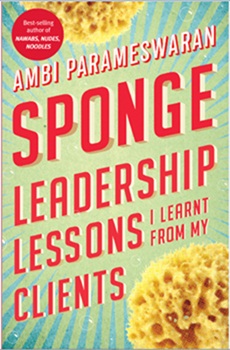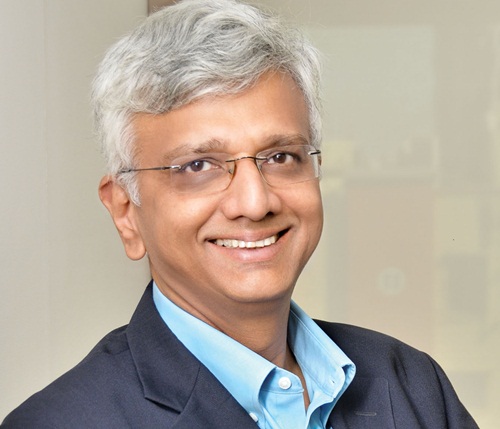Ambi Parameswaran is a brand strategist and founder of the brand advisory brand-building.co. A large part of his illustrious 40-year career was spent in advertising, first at Rediffusion and then a 25-year stint at FCB Ulka. He has worked on iconic brands and companies such as Tata, Wipro, Zee, TCS, Thermax, Indica, GSK, Tropicana, Abbott, ITC, etc.
Parameswaran now reads, writes, teaches and coaches leaders across multiple domains. He is a guest faculty at IIM-Calcutta and IIM-Ahmedabad and an adjunct professor of marketing at SPJIMR. His columns appear regularly in the Business Standard and the Mint, in addition to other business magazines and dailies. He is a distinguished alumnus awardee of IIT-Madras, an alumnus of IIM-Calcutta (where he served for 10 years on its board of governors), an AMP graduate from Harvard business School and a PhD in management from Mumbai university.
In this interview with Swetha Amit, Parameswaran talks about the idea behind his book Sponge, the importance of active listening and openness to learning.
What inspired the book and how did you come up with the interesting title Sponge?
I have been toying with the idea of a book about clients from whom I have learnt a lot, over the last four decades. The trigger was a conversation I had with a friend who is a respected professor in the US who was lamenting the fall of CEOs of the US. I thought I was lucky to have worked closely with so many wise clients, many in CEO positions. So, the idea was a book called What I Learnt From My Clients. Discussing this with my friend Anish Chandy, it dawned on me that the book needed a catchier title. And the concept of a sponge came up. Then we embellished it a bit to make the book broader bases; make it 'SPONGE - Leadership Lessons I Learnt from My Clients. The editor from Westland, Karthik agreed that this was a better title than what we had gone to the publisher with.
The crux of this book is that we could become better individuals by just listening and learning. Considering how people are constantly fiddling with their smart phones and technology, how do you suggest we revive the habit of listening and observing?
The concept of ‘active listening’ is one of the first steps I learnt when I got myself certified as a CEO Coach. Flipping sides, I realised that something that I had been practicing when I was with clients. Listening to what they are saying intensely.
The current generation is suffering from a serious dose of ‘attention-deficit disorder’; inability to get off the smart phone is just one big problem. Not the only one.
If you can listen deeply, or as I call it 'S' — 'super active listening', you can learn a lot.
One of your chapters talks about the peculiar challenges faced by those working in the area of customer service. Considering today’s age where customers are highly demanding and there is a lot of churn, how do you suggest companies deal with customer service?
Not only advertising, but in most B2B sectors, clients or customers are both revered and cursed in equal measure. This leads to great attrition and fall in morale. Business leaders tend to spread this kind of image about clients and customers. We need to reframe this equation to "what if we can approach each client interaction as a learning exercise." We may be able to build better relationships. And end up in a win-win situation.
You have also stated that hiring ex-servicemen in operational roles can provide Indian corporates a great window on getting work done. Considering we don’t see too many such people in corporate roles today, why do you think organisations today haven’t explored this possibility?
I am not sure why this has not happened and I have suggested some ideas in my book. It is an area where leading B Schools and the Indian Army, Navy, Air Force can collaborate to create viable alternative careers for officers who are on short service commissions. I have come across ex-army folks in HR and admin jobs. But I think they can be great assets in other positions as well.
In your chapter "Flying Without A Net", you have referred to the ‘high-achievers trap’ where high achievers suffer from fear of being wrong which causes frustration and blame games within them. Since your book emphasises the openness to learning, how do you purpose these high achievers come out of this trap?
I think high achievers have to be ready to admit that they can be wrong. And they can fail. The trap they often fall into is that they have to be successful at all costs. So, they tend to surround themselves with people who are ready to agree with them at every turn. What if you cultivate a team that is ready to argue and disagree. Then you will be able to take informed decisions, looking at all sides of the problem.
In your "Chaiwala" chapter, you have pointed out an interesting instance of how the team failed to display an aesthetic design, falling prey to certain stereotypes about classes and masses. How do you think brands and creative agencies can avoid falling into this trap?
The Chaiwala test that was used by one of my clients is a simple test to see if we are on the same page as our customer in aesthetic terms. I think we tend to underestimate the intelligence of our customers. We think they will not understand, they will not appreciate the nuances, they will not get it. So, we dumb things down. Instead we should be ready to go out and actually figure out what our customers are capable of appreciating. Don’t second guess. Set up a simple way of testing your hypotheses.
 Publisher:Westland Books / Price: Rs 350
Publisher:Westland Books / Price: Rs 350Interestingly, you have brought to light the concept of ‘The Halo Effect Trap’ where some clients and businesses prey on when dealing with celebrities, which affects the element of professionalism. How do you suggest that celebrity management companies try and bride this gap?
Indian clients are caught in a celebrity trap. So, they pay a celebrity a ton of money, while bargaining with the ad agency who is creating the communication. Instead they should reverse the situation. Do the work on the brand positioning and the advertising creative. Bring in the celebrity only after that, not as a ‘star’ but as an ‘actor’. Then you will be able to reuse the disturbing influence of the star ‘halo’.
In the chapter ‘The self-driven driver’ you have mentioned an interesting character ‘Ghousebhai’ who put the company’s needs and success ahead of his own personal goals. Considering the rise in levels of competition and selfishness these days, how do you think we can create more such self-driven Ghousebhais?
Creating more Ghousebhais should be the objective of every organisation. People who are self-motivated to do more, so that their company can succeed [and they can succeed]. Ghousebhai was the driver of the company car. But when the car was parked in the parking lot, Ghosebhai doubled up as the office peon and more. No-one asked him to do this double duty. He felt he should do it. Fortunately for him, the rest of the office appreciated him for it. So, the idea is if you have a Ghousebhai in your company what are you doing to him. Are you sending him to sleep in the car in the parking lot, or are you encouraging him to develop other skills.
‘Sponge’ has been an absorbing read. How was the experience of reliving some of your adman days? Any more books in the pipeline?
I think the book was an interesting exercise of digging up incidents that I had almost forgotten. Some of the stories are from the 1980s, those clients are no more. Many of the stories are from the mid '90s and 2000s. The challenge was to line up the stories, from across India, across different time zones, across different sets of clients. Once this was done I had to filter out the key lesson from each such interaction and liking it to a managerial concept. This took a lot of time. Fortunately, it has worked out well, as you are saying.
SPONGE - Leadership Lessons I Learnt from my Clients is my ninth book; the first six were more academic in nature and dealt with consumers, brands, advertising cases, etc. The next three [For God’s Sake; Nawabs Nudes Noodles; and SPONGE] are more professional books meant for working executives.
I may want to go back to writing about brands once again. When my first book came out in 2000 I thought that was it. Now 18 years later I am still writing. So, who knows?

 Publisher:Westland Books / Price: Rs 350
Publisher:Westland Books / Price: Rs 350






.webp)














